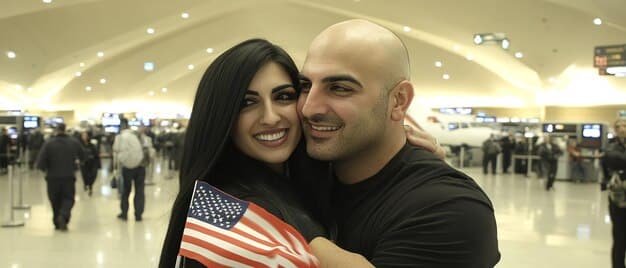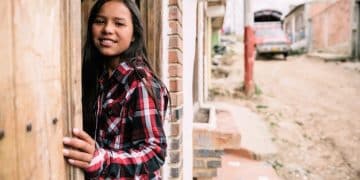Sponsor Peruvian Relatives: A Step-by-Step Guide to US Residency

Sponsoring your Peruvian relatives for US residency involves navigating the US immigration system, proving your relationship, demonstrating financial stability, and completing the necessary forms with USCIS. This guide provides a step-by-step overview to help you through the process.
Bringing your loved ones from Peru to the United States is a significant and rewarding endeavor. Understanding the process of how to sponsor your Peruvian relatives for US residency is the first step in reuniting your family.
Understanding US Immigration Law for Peruvian Relatives
The foundation of sponsoring Peruvian relatives for US residency lies in understanding the complex framework of US immigration law. Different categories exist for family-based immigration, each with its own set of requirements and limitations.
These categories are generally divided into immediate relatives and family preference categories. Immediate relatives, such as spouses, parents, and unmarried children under 21 of US citizens, have no annual limits on the number of visas issued. Family preference categories, which include other family relationships, are subject to annual limits and can involve longer waiting times.
Key Immigration Concepts
Before initiating the sponsorship process, it’s important to grasp some key immigration concepts.
- Priority Date: This is the date when USCIS (United States Citizenship and Immigration Services) receives your petition. It’s essentially your place in the waiting line for a visa.
- Visa Bulletin: Published monthly by the Department of State, the Visa Bulletin indicates the availability of immigrant visas for different categories and countries.
- Adjustment of Status: If your relative is already in the US, they may be eligible to adjust their status to permanent resident without having to return to Peru for visa processing.
- Consular Processing: If your relative is living in Peru, they will need to go through consular processing at the US Embassy in Lima.
Understanding these concepts will help you navigate the process more effectively and anticipate potential challenges. Knowing the specific category under which your relative qualifies is crucial for a successful application.
Initial Steps for Sponsorship
The initial steps for sponsoring your Peruvian relatives involve determining eligibility and filing the initial petition with USCIS. Accuracy and completeness are essential during this phase.
This part of the process sets the stage for the entire immigration journey. Any errors or omissions can lead to delays or even denial of the petition. Therefore, taking the time to gather all necessary documents and information is crucial.

Determining Eligibility
Ensure that you, as the US citizen or lawful permanent resident, meet the eligibility requirements to sponsor a relative. This includes being at least 18 years old and having a domicile in the United States.
Filing Form I-130
The first step is to file Form I-130, Petition for Alien Relative, with USCIS. This form establishes the familial relationship between you and your Peruvian relative. Include all required documentation, such as birth certificates, marriage certificates, and divorce decrees, to prove the relationship.
- Complete Form I-130 accurately and truthfully.
- Include copies of all required supporting documents.
- Pay the filing fee.
- Mail the petition to the appropriate USCIS service center.
After filing Form I-130, you will receive a receipt notice from USCIS. This notice confirms that USCIS has received your petition and is processing it. Keep this notice for your records, as it will be needed for future steps in the process.
The Affidavit of Support (Form I-864)
The Affidavit of Support, specifically Form I-864, is a critical component of the sponsorship process. It’s a legally binding contract between you and the US government, ensuring that your sponsored relative will not become a public charge.
This form demonstrates your ability to financially support your relative. The US government wants to ensure that immigrants are not dependent on public benefits. Meeting the income requirements is essential for the approval of the visa.
Meeting the Income Requirements
To qualify, you must demonstrate an income that is at least 125% of the poverty guideline for your household size, including the sponsored relative. You will need to provide proof of income, such as tax returns, W-2 forms, and pay stubs.
What if You Don’t Meet the Income Requirements?
If you don’t meet the income requirements on your own, there are options available. You can use assets, such as savings accounts, stocks, and bonds, to supplement your income. Additionally, a joint sponsor can be used if you cannot meet the income requirements alone.
- Consider using assets to meet the financial requirements.
- Explore the possibility of having a joint sponsor.
- Ensure all financial documents are accurate and up-to-date.
A joint sponsor must also meet the income requirements and be willing to accept legal responsibility for supporting your relative. The joint sponsor will need to complete their own Affidavit of Support and provide supporting documentation. It’s important to carefully vet potential joint sponsors to ensure they meet the requirements and are committed to fulfilling their obligations.
Consular Processing in Peru
If your Peruvian relative is residing in Peru, they will need to undergo consular processing at the US Embassy in Lima. This involves completing additional forms, attending an interview, and undergoing a medical examination.
Consular processing can be a lengthy and complex process. It’s important to carefully follow the instructions provided by the National Visa Center (NVC) and the US Embassy in Lima. Preparing for the interview and gathering all necessary documents are crucial for a successful outcome.

National Visa Center (NVC)
Once Form I-130 is approved, the case will be sent to the National Visa Center (NVC). The NVC will instruct your relative to pay visa fees and submit required documents, such as the DS-260 Application for Immigrant Visa.
Interview at the US Embassy
After the NVC reviews the documents, an interview will be scheduled at the US Embassy in Lima. Your relative should be prepared to answer questions about their relationship to you, their intentions in the US, and their background.
- Complete Form DS-260 accurately and truthfully.
- Gather all required documents, including passport, birth certificate, and police certificates.
- Prepare for the interview by reviewing common questions and practicing answers.
The interview is a crucial part of the consular processing. The consular officer will assess your relative’s eligibility for a visa and their intentions to comply with US immigration laws. It’s vital to present yourself honestly and respectfully during the interview.
Adjustment of Status in the US
If your Peruvian relative is already legally present in the US, they may be eligible to adjust their status to permanent resident without returning to Peru.
Adjustment of status can save time and travel expenses. However, it’s essential to meet all eligibility requirements and file the necessary forms correctly. Failure to do so can result in denial of the application and potential deportation.
Eligibility Requirements
To be eligible for adjustment of status, your relative must be physically present in the US, have a valid visa, and not have violated their immigration status. They must also be admissible to the US, meaning they must not have a criminal record or other issues that would prevent them from entering the country.
Filing Form I-485
The primary form for adjustment of status is Form I-485, Application to Register Permanent Residence or Adjust Status. This form must be filed with USCIS, along with supporting documentation, such as birth certificates, marriage certificates, and immigration documents.
- Ensure your relative meets all eligibility requirements.
- Complete Form I-485 accurately and truthfully.
- Include all required supporting documents.
After filing Form I-485, your relative may be required to attend an interview at a USCIS office. The interview is similar to the consular processing interview and serves to verify the information provided in the application. It’s important to be prepared to answer questions about your relationship and background.
Common Challenges and How to Overcome Them
The process of sponsoring a Peruvian relative can present several challenges. Understanding these potential obstacles and having a plan to address them can increase your chances of success.
Immigration processes can be complicated, and encountering roadblocks is not uncommon. Addressing these challenges with patience, thorough preparation, and professional guidance can help ensure a smooth and successful journey.
Dealing with Delays
Delays are a common frustration in the immigration process. Processing times can vary depending on the type of visa, the volume of applications, and the USCIS service center. Check the USCIS website for current processing times and be prepared for potential delays.
Addressing Denials
If your petition or application is denied, you have the right to appeal the decision or file a motion to reopen the case. Review the denial notice carefully to understand the reasons for the denial and gather additional evidence to support your case.
- Seek legal assistance from an immigration attorney if needed.
- Gather additional evidence to support your case.
- Be patient and persistent throughout the process.
Navigating the complex world of US immigration law can be daunting. Seeking assistance from an experienced immigration attorney can provide valuable guidance and support. An attorney can help you understand the requirements, prepare your case, and represent you before USCIS and the immigration courts.
| Key Aspect | Brief Description |
|---|---|
| 📝 Eligibility | Confirm that the sponsor and relative meet the necessary requirements. |
| 📄 Form I-130 | File the Petition for Alien Relative with USCIS to establish the relationship. |
| 💰 Affidavit of Support | Demonstrate sufficient financial resources with Form I-864. |
| 🛂 Consular Processing | Complete the visa application process at the US Embassy in Lima. |
Frequently Asked Questions
▼
The processing time varies based on the visa type, country of origin, and USCIS workload. Immediate relatives generally experience shorter wait times compared to preference categories, and it can take several months to years.
▼
If the sponsor’s income is insufficient, they can include the value of their assets or seek a joint sponsor. A joint sponsor must meet the income requirements and accept legal responsibility for supporting the immigrant.
▼
Yes, lawful permanent residents can sponsor certain relatives, such as spouses and unmarried children. However, the categories and waiting times may differ compared to sponsorships by US citizens.
▼
You’ll need documents such as birth certificates, marriage certificates, and adoption papers to prove the family relationship. These documents must be official and may need to be translated into English.
▼
The DS-260 is an online immigrant visa application required for consular processing. It must be completed and submitted to the NVC after the I-130 petition is approved and before the visa interview at the US embassy.
Conclusion
Sponsoring your Peruvian relatives for US residency is a complex yet fulfilling journey, involving careful planning, meticulous documentation, and adherence to US immigration laws. By understanding each step and seeking expert assistance when needed, you can navigate the process successfully, bringing your loved ones closer to a new life in the United States. Remember to stay informed about the latest USCIS guidelines and requirements to ensure a smooth and efficient process.





